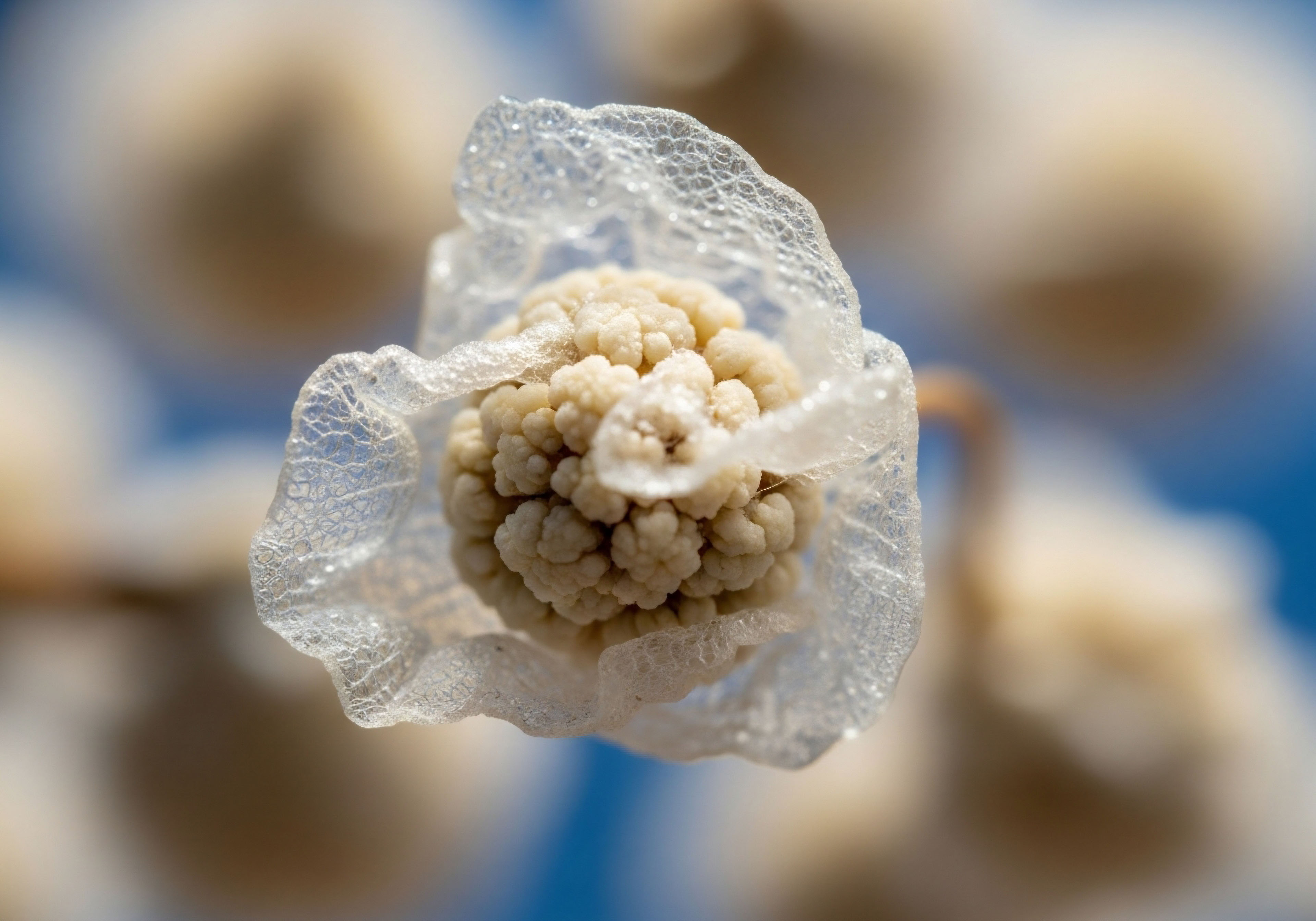

Fundamentals
You have arrived here because you are listening to your body. The subtle and sometimes overt signals ∞ changes in energy, shifts in mood, a body that feels unfamiliar ∞ have prompted a search for answers, for a way to reclaim a sense of vitality that feels like your own.
This process of inquiry is the first and most significant step in a personal health journey. Your experience is valid, and the path toward understanding the intricate biological systems that govern your well-being begins with a single, foundational concept ∞ cellular communication. Before we can optimize our complex hormonal systems, we must first ensure the messages being sent are being received clearly. This is the world of inositol.
Inositol is a class of molecules that our bodies produce and that are present in the foods we eat. It functions as a fundamental component of cellular structure and, more importantly, as a biological interpreter. Think of your hormones as messengers delivering critical instructions throughout your body.
For these instructions to be carried out, the cell must first hear the message and then translate it into action. Inositol acts as a key part of this translation team, a “second messenger” that takes the hormone’s initial signal from the cell’s outer membrane and carries it deep within the cell to trigger a specific response. It ensures the message is received, understood, and acted upon with precision.
Inositol functions as a crucial second messenger, translating hormonal signals into direct cellular action.

The Central Role of Insulin Signaling
The most well-documented role for inositol is in its partnership with insulin, the master hormone of metabolic regulation. Insulin’s primary job is to manage the body’s energy supply by instructing cells to absorb glucose from the bloodstream. When you consume a meal, your body releases insulin, which then binds to receptors on your cells.
This is where inositol steps in. It facilitates the complex chain of events that opens the door for glucose to enter the cell, providing it with the fuel it needs to function. A healthy sensitivity to insulin means this process is efficient and seamless. The body produces the right amount of insulin, the cells hear the signal, and glucose is managed effectively.
When this communication system becomes impaired, a condition known as insulin resistance develops. The cells become “deaf” to insulin’s signal. In response, the body attempts to overcome this deafness by shouting louder ∞ producing more and more insulin. This state of high insulin, or hyperinsulinemia, creates a cascade of systemic disruptions.
High levels of circulating insulin can directly influence the production and balance of other key hormones, including testosterone, estrogen, and cortisol. It is a state of biological noise that interferes with the delicate conversations happening constantly within your endocrine system. Addressing this foundational imbalance is a primary objective in any comprehensive wellness protocol.
By supporting the clarity of insulin signaling, inositol helps to quiet this biological noise, creating a stable environment where other hormonal therapies can perform their intended functions effectively.

Two Key Interpreters Myo-Inositol and D-Chiro-Inositol
Within the inositol family, two isomers are of primary clinical importance ∞ myo-inositol (MI) and D-chiro-inositol (DCI). These are not interchangeable; they are distinct molecules with specialized roles, existing in a carefully maintained balance within the body’s tissues.
- Myo-inositol (MI) is the most abundant form, found in virtually all tissues. It is the primary storage form and the precursor to other inositol isomers. Its main function is to facilitate glucose uptake into cells and to act as a second messenger for other critical hormones, including Follicle-Stimulating Hormone (FSH) and Thyroid-Stimulating Hormone (TSH). This makes it essential for ovarian function and thyroid health.
- D-chiro-inositol (DCI) is synthesized from MI by an insulin-dependent enzyme called epimerase. Its production increases when insulin levels rise. DCI’s primary role is to activate the enzymes responsible for storing glucose as glycogen. It essentially handles the “next step” after MI has helped get glucose into the cell.
A healthy body maintains a specific physiological ratio of MI to DCI, typically around 40 to 1 in the bloodstream. This balance ensures that both the uptake and the storage of glucose are managed efficiently. Disruptions in insulin signaling can impair the conversion of MI to DCI, leading to imbalances that contribute to metabolic and hormonal dysfunction.
Understanding these two key players is the first step toward appreciating how a targeted inositol supplementation strategy can be tailored to support specific health goals, laying a robust foundation for broader hormonal optimization.


Intermediate
Building upon the understanding that inositol is a key cellular communicator, we can now examine its application within specific clinical protocols. The integration of inositols with hormonal optimization therapies is a strategy of synergy. It prepares the cellular environment to be more receptive and efficient, allowing targeted hormonal treatments to achieve their full potential.
The approach is tailored, recognizing that the needs of men and women differ and that the choice between myo-inositol (MI), D-chiro-inositol (DCI), or a combination thereof depends entirely on the therapeutic goal.

Protocol Integration for Female Hormonal Health
For women, particularly those navigating Polycystic Ovary Syndrome (PCOS) or the metabolic shifts of perimenopause and post-menopause, inositol therapy is a cornerstone of foundational support. The common denominator in these conditions is often a degree of insulin resistance, which disrupts the delicate interplay of the Hypothalamic-Pituitary-Ovarian (HPO) axis.
In the context of PCOS, hyperinsulinemia directly stimulates the ovaries to produce excess androgens (like testosterone) and disrupts the pulsatile release of Luteinizing Hormone (LH) and Follicle-Stimulating Hormone (FSH) from the pituitary. This leads to the hallmark symptoms of irregular cycles, anovulation, and clinical signs of hyperandrogenism. Supplementation with a physiological ratio of MI and DCI (typically 40:1) has been shown to improve insulin sensitivity. This improvement has several downstream benefits:
- Restored Ovarian Function ∞ By lowering insulin levels, the overstimulation of the ovaries is reduced, which can help lower androgen production. Concurrently, MI directly supports FSH signaling within the ovary, which is critical for follicle development and oocyte quality.
- Improved Menstrual Regularity ∞ Normalizing the LH/FSH ratio helps to restore predictable ovulation and menstrual cycles.
- Metabolic Health ∞ The benefits extend to improvements in blood pressure, triglyceride levels, and management of body weight, all of which are common concerns in women with PCOS.
For women in perimenopause and post-menopause receiving hormone replacement therapy (HRT), inositol serves a complementary role. As estrogen declines, women become more susceptible to developing insulin resistance. Inositol supplementation can help manage these metabolic changes, supporting stable blood sugar and energy levels. This creates a more stable internal environment, potentially allowing for lower effective doses of bioidentical hormones and improving overall treatment outcomes.

What Is the Role of Inositol in Male Hormonal Optimization?
The application of inositol in male hormonal health, specifically alongside Testosterone Replacement Therapy (TRT), requires a more nuanced approach. While high levels of insulin can also negatively impact men by increasing the activity of the aromatase enzyme, which converts testosterone into estrogen, the choice of inositol isomer is critical. In this context, D-chiro-inositol (DCI) has demonstrated unique properties.
Research suggests that DCI may help to modulate aromatase expression. By downregulating this enzyme, DCI can help preserve testosterone and maintain a healthier testosterone-to-estrogen (T/E) ratio. This is particularly relevant for men on TRT who may be prone to elevated estrogen levels, a side effect that can undermine the benefits of therapy and necessitate the use of ancillary medications like anastrozole.
In men, D-chiro-inositol may support healthy testosterone-to-estrogen ratios by modulating the activity of the aromatase enzyme.
A pilot study involving older men with low baseline testosterone found that daily supplementation with DCI led to a significant increase in testosterone and androstenedione levels, alongside a reduction in estrogen concentrations. The participants also experienced improvements in glycemic control and body composition. Therefore, for a man on a TRT protocol, a targeted DCI supplementation could be a synergistic addition aimed at optimizing the hormonal milieu and improving metabolic health concurrently.
| Protocol | Primary Inositol Isomer(s) | Mechanism of Action | Therapeutic Goal |
|---|---|---|---|
| Female (PCOS) | Myo-Inositol & D-Chiro-Inositol (40:1 Ratio) | Improves systemic insulin sensitivity, supports ovarian FSH signaling. | Reduce hyperandrogenism, restore ovulation, improve metabolic markers. |
| Female (Peri/Post-Menopause) | Myo-Inositol | Manages emergent insulin resistance associated with estrogen decline. | Support metabolic stability, enhance efficacy of HRT. |
| Male (TRT) | D-Chiro-Inositol | Improves insulin sensitivity and modulates aromatase expression. | Optimize testosterone-to-estrogen ratio, reduce need for aromatase inhibitors. |
| Growth Hormone Peptides | Myo-Inositol | Enhances cellular energy metabolism and insulin/IGF-1 signaling pathways. | Improve cellular responsiveness to anabolic signals from GH/IGF-1. |

Synergy with Growth Hormone Peptide Therapy
Growth hormone (GH) peptide therapies, such as Sermorelin and Ipamorelin/CJC-1295, function by stimulating the pituitary gland to release more of the body’s own growth hormone. The ultimate benefits of this therapy ∞ improved body composition, enhanced recovery, and tissue repair ∞ depend on the ability of the cells to respond to the downstream signals of GH and its primary mediator, Insulin-like Growth Factor 1 (IGF-1).
The signaling pathway for IGF-1 shares significant components with the insulin signaling pathway. Therefore, ensuring this pathway is functioning optimally is key to maximizing the benefits of peptide therapy.
Myo-inositol, by ensuring the health of this shared signaling cascade, acts as a preparatory agent. It ensures the cellular machinery is primed and ready to execute the anabolic and restorative commands initiated by the increase in GH and IGF-1.
A study combining lysine, vitamin B12, and inositol found it promoted growth in children by increasing serum levels of GHRH, GH, and IGF-1, suggesting a supportive role within the GH axis. For an adult engaged in a peptide protocol for wellness or longevity, supporting this foundational cellular process with myo-inositol can help ensure the investment in peptide therapy yields the most robust and consistent results.


Academic
A sophisticated analysis of inositol’s role within hormonal optimization protocols requires a systems-biology perspective, moving beyond isolated effects to understand its function as a modulator of the body’s core signaling architecture. The central nexus of this architecture is the interplay between metabolic control and reproductive endocrinology, specifically the bidirectional communication between insulin signaling pathways and the Hypothalamic-Pituitary-Gonadal (HPG) axis.
Inositols, in their isomeric forms of myo-inositol (MI) and D-chiro-inositol (DCI), are positioned at the very heart of this intersection, acting as pleiotropic signaling molecules that translate metabolic status into endocrine response.

Inositol Phosphoglycans as Endocrine Modulators
The mechanism of inositol action extends beyond its presence in cell membranes. Upon insulin receptor activation, a specific phospholipase C hydrolyzes glycosylphosphatidylinositol (GPI) anchors in the cell membrane, releasing inositol phosphoglycans (IPGs). These IPGs, containing either MI or DCI, function as extracellular and intracellular second messengers of insulin action, mediating many of its metabolic effects. This mechanism is central to understanding how systemic metabolic health, governed by insulin, directly influences the endocrine system at a cellular level.
The HPG axis is exquisitely sensitive to metabolic cues. Gonadotropin-releasing hormone (GnRH), secreted by the hypothalamus, stimulates the pituitary to release LH and FSH. This signaling process itself utilizes inositol-based pathways. Insulin resistance and the resultant hyperinsulinemia create a state of altered IPG signaling.
This dysregulation has profound, sex-specific consequences on the HPG axis. In women, particularly in the context of PCOS, excessive insulin signaling leads to increased activity of the enzyme epimerase, which converts MI into DCI. This creates a critical imbalance within the ovary.

How Does the Ovarian Paradox Influence Therapy?
The concept of the “ovarian paradox” is essential for clinical application. While many peripheral tissues become resistant to insulin in PCOS, the ovary appears to remain sensitive, or even hypersensitive, to its effects. The high insulin levels drive excessive conversion of MI to DCI within the ovarian microenvironment.
This is problematic because the ovary requires a very high ratio of MI to DCI (approximately 100:1) for proper function. Myo-inositol is the key second messenger for FSH signaling, a process vital for healthy follicular development and oocyte maturation.
A localized depletion of MI and an excess of DCI within the ovary impairs FSH signaling, contributing to poor oocyte quality and anovulation. Systemically, the body is insulin resistant; locally, at the ovary, the consequences of hyperinsulinemia disrupt reproductive function through inositol depletion.
This understanding justifies the clinical use of a combined MI/DCI 40:1 formulation for PCOS. The goal is to restore the physiological systemic ratio, which in turn helps to normalize the intra-ovarian environment by providing sufficient MI substrate.
The ovarian paradox in PCOS highlights a tissue-specific disruption of inositol balance, where systemic insulin resistance causes local myo-inositol depletion in the ovary, impairing follicular health.
| Parameter | Myo-Inositol (MI) | D-Chiro-Inositol (DCI) |
|---|---|---|
| Primary Function | Second messenger for FSH, TSH, and Insulin; facilitates cellular glucose uptake. | Second messenger for insulin; activates enzymes for glycogen synthesis. |
| Conversion | Serves as the precursor to DCI via the epimerase enzyme. | Synthesized from MI in response to insulin stimulation. |
| Tissue-Specific Role (Ovary) | Crucial for FSH signaling and oocyte quality; requires a high MI:DCI ratio (~100:1). | Excess DCI impairs oocyte quality and follicular development. |
| Tissue-Specific Role (Male) | Foundational role in cellular metabolism and signaling. | May modulate aromatase expression, influencing the T/E ratio. |
| Clinical Implication | Essential for female fertility protocols and foundational metabolic support. | Targeted use in male hormonal protocols for aromatase management. |

Aromatase Modulation and the Male HPG Axis
In men, the integration of inositol, specifically DCI, into hormonal protocols hinges on its interaction with steroidogenesis. The enzyme aromatase (CYP19A1) catalyzes the conversion of androgens (testosterone, androstenedione) into estrogens (estradiol, estrone). Its expression is influenced by a variety of factors, including insulin levels. In states of hyperinsulinemia and obesity, aromatase activity is often upregulated, leading to a lower testosterone-to-estrogen ratio, which can contribute to the symptoms of hypogonadism and undermine the efficacy of TRT.
Emerging research has demonstrated that DCI can downregulate aromatase expression in a dose-dependent manner. The precise molecular mechanism is still under investigation but is thought to involve DCI’s role as an insulin-sensitizer, reducing the primary stimulus for excess aromatase activity.
A pilot study in older hypogonadal men found that 1200 mg/day of DCI for 30 days significantly increased total testosterone and free testosterone while concurrently decreasing estradiol levels. This presents a compelling therapeutic rationale. By integrating DCI into a TRT protocol, a clinician can address the underlying metabolic driver of estrogen excess.
This approach aligns with a systems-biology model, targeting the root cause of the imbalance to create a more favorable hormonal environment, potentially improving outcomes and reducing reliance on direct aromatase inhibitors like anastrozole. The use of DCI becomes a tool for fine-tuning the HPG axis by modulating a key enzymatic control point in steroid hormone metabolism.

References
- Bezerra, Flávia Maciel, et al. “Myo-inositol for insulin resistance, metabolic syndrome, polycystic ovary syndrome and gestational diabetes.” Gynecological Endocrinology, vol. 38, no. 3, 2022, pp. 187-192.
- Bizzarri, Mariano, and Antonio Simone Laganà. “Inositols in Insulin Signaling and Glucose Metabolism.” International Journal of Endocrinology, vol. 2018, 2018, p. 8928620.
- Gambioli, Riccardo, et al. “The use of D-chiro-Inositol in clinical practice.” European Review for Medical and Pharmacological Sciences, vol. 25, no. 1, 2021, pp. 438-446.
- Greff, Daniele, et al. “The Effects of Myo-Inositol and D-Chiro-Inositol in a Ratio 40:1 on Hormonal and Metabolic Profile in Women with Polycystic Ovary Syndrome Classified as Phenotype A by the Rotterdam Criteria and EMS-Type 1 by the EGOI Criteria.” Gynecologic and Obstetric Investigation, vol. 88, no. 1, 2023, pp. 35-42.
- Monastra, Giovanni, et al. “d-Chiro-Inositol improves testosterone levels in older hypogonadal men with low-normal testosterone ∞ a pilot study.” Basic and Clinical Andrology, vol. 31, no. 1, 2021, p. 28.
- Nestler, John E. et al. “Ovulatory and metabolic effects of D-chiro-inositol in the polycystic ovary syndrome.” New England Journal of Medicine, vol. 340, no. 17, 1999, pp. 1314-1320.
- Nordio, M. and E. Proietti. “The combined therapy with myo-inositol and D-chiro-inositol reduces the risk of metabolic disease in PCOS overweight patients compared to myo-inositol supplementation alone.” European Review for Medical and Pharmacological Sciences, vol. 16, no. 5, 2012, pp. 575-581.
- Sun, Fengping, et al. “Exercise combined with lysine-inositol vitamin B12 promotes height growth in children with idiopathic short stature.” Growth Hormone & IGF Research, vol. 69-70, 2023, p. 101535.

Reflection

Calibrating Your Internal Systems
The information presented here offers a map of intricate biological pathways and clinical strategies. This knowledge is a powerful tool, yet its true value is realized when it is transformed into personal wisdom. Your body is a unique and dynamic system, with its own history, sensitivities, and requirements.
The data points, the lab markers, and the clinical protocols are objective measures, but they find their meaning in the context of your subjective experience ∞ how you feel, function, and move through your life.
Consider this exploration of inositols and hormonal health as a new lens through which to view your own physiology. It is an invitation to look deeper, to ask more precise questions, and to understand the profound connections between your metabolic health and your hormonal vitality.
The ultimate goal of any optimization protocol is to restore the body’s own intelligent, self-regulating processes. The path forward involves a collaborative partnership with a clinical guide who can help you interpret your body’s signals, analyze your unique data, and craft a personalized protocol that aligns with your specific biology. You have already begun this work by seeking to understand. The next step is to apply that understanding to your own personal journey toward reclaiming your fullest potential.



